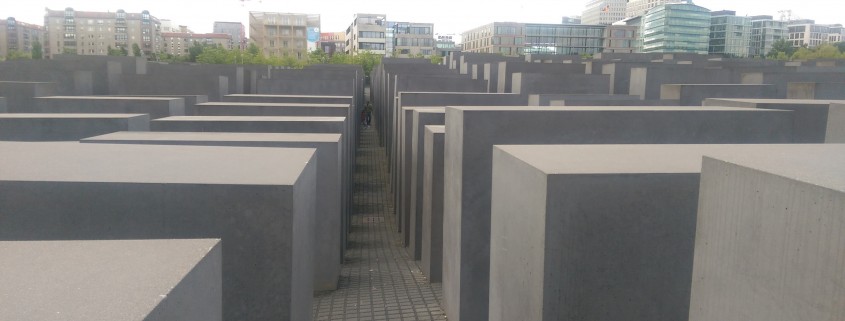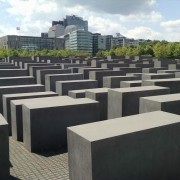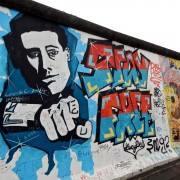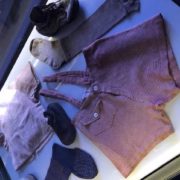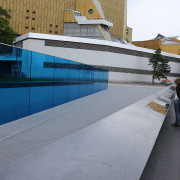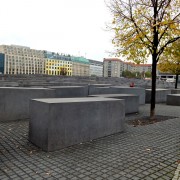Memorials and Memory
By Elon Clarke
Day after day on this trip, the other students and I remark on the sheer number of memorials, cemeteries and monuments to death and murder we have encountered. The usual speech to accompany the opening of a monument entails explanations of how this piece of art commemorates the lost or exalted, however not every monument properly plays its role as commemorator. The way people, victims or saints, are memorialized is related to the lessons their deaths teach. Inadequate monuments send inadequate messages.
Having visited the Monument to the Murdered Jews of Europe, the persecuted Homosexuals under Nazism, murdered Roma and Sinti, the Disabled Victims there are a few criticisms that could improve, at the very least, the Monument to the Murdered Jews of Europe and The Monument to the Persecuted Homosexuals. These monuments usually span acres or cost millions of dollars or are almost intimidating monoliths (or all of the above) to properly commemorate the victims. However, the victims I’m sure would like more than perhaps some rocks and a thin conversation to hold their memory, but perhaps change.
Arriving at the Berlin Monument to the Murdered Jews of Europe is not a harrowing experience, I do not feel it properly represents or commemorated the attempted and nearly complete extermination of an entire people. I was not aware upon first glance that what I was seeing was not modern art in public space. I was not aware that I was not looking at a meeting place for art students or a stunt ground for skaters and children. It was only when I was specifically told by my professor what I was looking at could I even begin to create an inner dialogue about the possible meaning of the various smooth stone slabs before me. Upon entering the Monument the ground is uneven and the stones vary in height. They create a certain maze that is not however too hard to navigate. On a second glance the monoliths resemble tombstones, vast in weight, girth, and height and perhaps attempt to memorialize the millions of murdered people over the span of six years that one cemetery could not hope to contain. This inner discussion is only a result of knowing beforehand what I was entering. The monument was filled with people who obviously had no idea they were hopping and climbing on symbolic headstones. In order to elicit a discussion or any grave remembrance one has to know that what they are seeing is a memorial to a genocide and not a playground. I was sorely disappointed. The biggest flaw in this monument is the lack of public recognition.
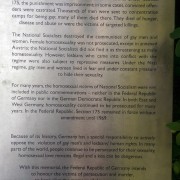
Memorial Notation to Murdered Homosexuals of Europe during the Holocaust. (After not noticing and walking back to the entrance of the park)
In the same vein of disappointment I speak of the Monuments to the Persecuted Homosexuals under Nazism. The only similarity I could detect between these two monuments was the physical shape and feel. Both were composed of large stones with extremely smooth faces that could be mistaken for something else at first glance. One would know these two monuments were related by their similar outward appearance. However, as opposed to the Monument to Murdered Jews, Monument to Persecuted Homosexuals had a visual media component. When a viewer looked inside the stone through a small window, he or she could see a film showing two men kissing. This kiss in my view was more than a simple kiss but rather an intimate embrace. By Intimate I do not mean sexual but rather very private and happening between two close people. In their kiss and whisper were feelings and emotions that need not be shown to the public eye. Apart from this, this was a monument not just to gay men who were targeted but also to other “others”. (That is, those who threaten the norm such as lesbians) This monument also raises the issue of recognition. Any non-student passing would not know this is a memorial but perhaps rather a performance art piece meant to shock the homophobes. Only many meters away near the entrance to the park is there a plaque explaining this piece being a monument to the murdered homosexuals and even that is obscured by bushes and a temporary fence on the day we visited. We had to backtrack to read the sign.
These monuments left me with so many questions that did not have much to do with design but more with the reason for their construction and existence. “Why is this here?” I left them upset, not because of the suffering of the victims but because of the inadequacy of their memorials there. The suggestions for small improvements are simple; visibly and noticeably identify the people for whom the memorial was created. It seems as though these few memorials in Berlin were built to shut a door and end a conversation rather than begin a discussion. Only with discussion can change occur, can lessons be learned and messages heard.

